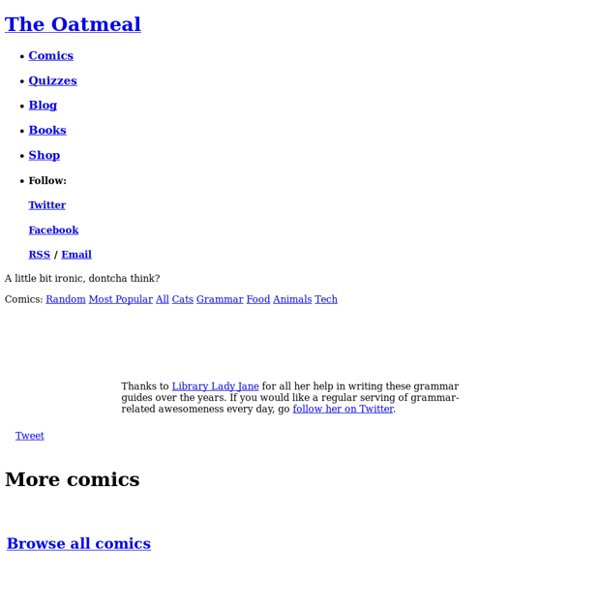



http://theoatmeal.com/comics/irony
17 Tips To Make Your Life Easier - Aimless Direction — Aimless Direction I received this as an email and instead of saving the email, I decided to post it here so that I know I always have these great tips on my site. I plan on trying every single one of them too. I actually just tried the dryer tip (#17) at the bottom, so we’ll see how that one works out. Oh yeah, I probably won’t be trying the hair conditioner on my legs for shaving either since, well…I’m a guy. A lot of these tips are things that I can actually use on a regular basis too. 1. Graffiti from Pompeii I.10.4 (near the rear entrance vestibule of the House of Menander); 8356: At Nuceria, look for Novellia Primigenia near the Roman gate in the prostitute’s district. I.10.4 (exterior of the House of Menander); 8304: Satura was here on September 3rd I.10.7 (House and Office of Volusius Iuvencus; left of the door); 8364: Secundus says hello to his Prima, wherever she is. I ask, my mistress, that you love me.
Lesson Overview | Does the emphasis on reading “informational text” in the new Common Core State Standards set up a “fiction versus nonfiction smackdown” in English classes? If so, is that good or bad? In this lesson, students will reflect on their reading experiences in and out of school and discuss the roles that both nonfiction and fiction have played. Then, they will become familiar with what the Common Core standards say about reading, and what critics and supporters have written in reaction, in order to discuss and write about the question “What Should Children Read?” Materials | Our Reading Questionnaire handout Warm-Up | Ask students to complete our Reading Questionnaire (PDF) to begin thinking about their own reading histories, habits and preferences — and about the roles of fiction and nonfiction in their lives.
Figure of speech A figure of speech is the use of a word or a phrase, which transcends its literal interpretation. It can be a special repetition, arrangement or omission of words with literal meaning, or a phrase with a specialized meaning not based on the literal meaning of the words in it, as in idiom, metaphor, simile, hyperbole, personification, or synecdoche. Figures of speech often provide emphasis, freshness of expression, or clarity. How to Read a Hebrew Tombstone Jewish tombstones with Hebrew inscriptions have an added value to genealogists, in that they not only show the date of death and sometimes the age or date of birth, but they also include the given name of the deceased's father. This permits you to go back one more generation. Here are a few helpful pointers if you cannot read Hebrew.
Power Poetry Our Data Check out our awesome data on Power Poetry and our poets. Meet the Power Poetry team and discover what we do. Welcome! 20 Questions You Should Ask Yourself Every Sunday post written by: Marc Chernoff Email At the cusp of new beginnings many of us take time to reflect on our lives by looking back over the past and ahead into the future. We ponder the successes, failures and standout events that are slowly scripting our life’s story. This process of self reflection helps maintain a conscious awareness of where we’ve been and where we intend to go. Understanding Language In the first lesson in this unit, students are introduced to the use of persuasion in visual, print, and multimodal advertisements. Many advertisements, particularly video, embed persuasive techniques in the familiar genre of narrative first to inform, engage, and interest readers and viewers emotionally, and then to persuade them to take some form of action. This action may be to buy a product, sign a petition, attend an event, or change their behavior. Sometimes the purpose is to raise awareness of an issue –the action or response required is not always made explicit. This lesson explores how the use of persuasive techniques within the narrative of advertisements accomplishes these goals.
30 Sites To Help You Open Doors To a New Career Lately it seems like everyone is getting laid off and those who have been able to hold their jobs are worried sick. We have been hit with layoffs for quite a while now and with that job insecurity has started taking toll on some people. However, most people don’t realize the possibilities that lie ahead of them.